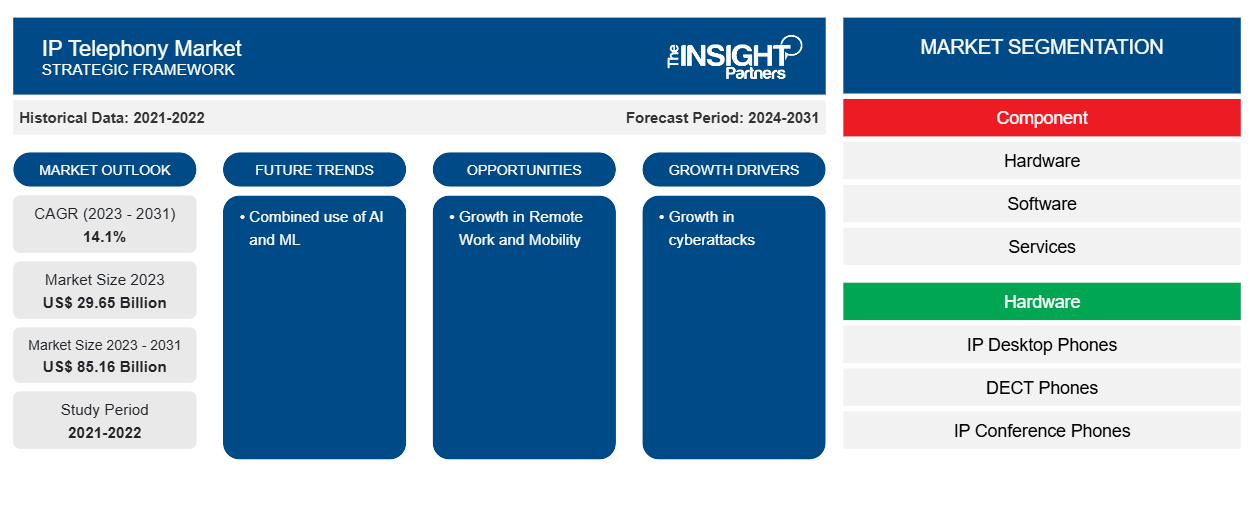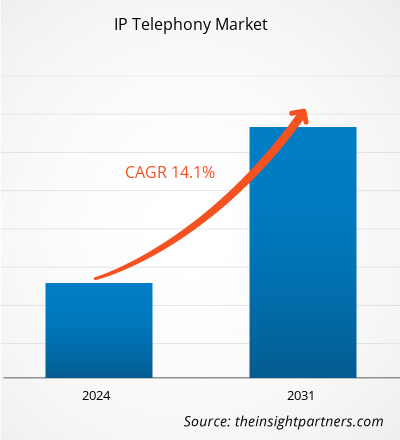IP テレフォニー市場の規模は、2023 年の 296.5 億米ドルから 2031 年には 851.6 億米ドルに達すると予測されています。IP テレフォニー市場は、2023 年から2031 年にかけて 14.1% のCAGRを記録すると予想されています。Voice over IP (VoIP) は、IP テレフォニーの傘下にあるサービスおよびアプリケーションです。これは、IP ネットワークを介した音声通信の伝送です。
IPテレフォニー市場分析
インターネット プロトコル (IP) テレフォニーは、音声通話、ビデオ通話、ボイスメール、ファックス、インスタント メッセージング (1M)、ビデオ会議など、さまざまなサービスを提供します。IP テレフォニーは、VolPとは異なり、多くの場合、音声機能以上の機能を提供します。IP テレフォニーは、電話機能とインターネット機能を組み合わせたネットワークを提供することで、あらゆる規模の組織にメリットをもたらします。IP テレフォニーは、コストが低く、インフラストラクチャがシンプルで、拡張性があり、モビリティも優れているため、エンド ユーザーにとって魅力的です。
IPテレフォニー市場の概要
IP テレフォニーとは、ファックスやその他のテクノロジーを含む、インターネットベースの通信に含まれるあらゆるシステムを指します。さまざまなオープンソース プロトコルを使用して、電話からサービス プロバイダーにデータを送信します。企業は、携帯性とコスト効率の良さから、IP テレフォニー ソリューションを急速に導入しています。さらに、IP テレフォニー システムは使いやすく、高度なテクノロジーを提供し、生産性を向上させます。これらの要因が、IP テレフォニー システムの採用を推進しています。IP テレフォニーは、ビジネス フォンに新しい機能を追加し、コスト効率の高いソリューションを提供することでコミュニケーションを改善します。これは、世界中の IP テレフォニー市場の主要な推進力であると考えられています。ファックス機、クレジットカード リーダー、アラームなどの既存のレガシー システムとハードウェアは、IP 電話システムに簡単にリンクできます。
要件に合わせてレポートをカスタマイズする
このレポートの一部、国レベルの分析、Excelデータパックなど、あらゆるレポートを無料でカスタマイズできます。また、スタートアップや大学向けのお得なオファーや割引もご利用いただけます。
- このレポートの主要な市場動向を入手してください。この無料サンプルには、市場動向から見積もりや予測に至るまでのデータ分析が含まれます。
IPテレフォニー市場の推進要因と機会
サイバー攻撃の増加が市場を有利に導く
近年、急速な技術進歩により脆弱性が増加しています。サイバー攻撃が一般的になるにつれ、企業はIPテレフォニー製品やサービスにますます依存するようになっています。IBMは、企業におけるデータ侵害の総コストは2021年だけで約6兆米ドルになると見積もっています。この数字は、予想される期間中に増加すると予想されています。そのため、企業はデータを保護し、侵害を防ぐためにIPテレフォニーソリューションを導入しており、予測期間を通じてIPテレフォニー市場のCAGRを押し上げると予想されています。
リモートワーク文化の台頭
モバイル デバイスの使用が増え、リモート ワーク カルチャーが広まるにつれ、適応性に優れ、すぐに利用できる IP テレフォニー ソリューションの需要が高まっています。従業員は、スマートフォン アプリを使用してどこからでも電話をかけたり受けたりすることがますます増えています。さらに、リモート コラボレーションには、ビデオ会議ソフトウェアを使用した通信が必要です。IP テレフォニー プロバイダーは、こうした変化するニーズに対応するソリューションの開発に注力しています。
IPテレフォニー市場レポートのセグメンテーション分析
IP テレフォニー市場分析の導出に貢献した主要なセグメントは、コンポーネント、ハードウェア、サービス、インストール タイプ、エンタープライズ タイプ、およびエンド ユーザーです。
- コンポーネントに基づいて、IP テレフォニー市場はハードウェア、ソフトウェア、およびサービスに分かれています。
- ハードウェア別に見ると、市場は IP デスクトップ電話、DECT 電話、IP 会議電話に分類されます。
- サービスに基づいて、IP テレフォニー市場はインストールとメンテナンス、および専門サービスに分かれています。
- 設置タイプに基づいて、IP テレフォニー市場は有線と無線に分類されます。
- 企業規模に基づいて、IP テレフォニー市場は中小企業と大企業に分類されます。
- エンドユーザーに基づいて、IP テレフォニー市場は住宅、企業、政府機関に分類されます。
地域別 IP テレフォニー市場シェア分析
IP テレフォニー市場レポートの地理的範囲は、主に北米、アジア太平洋、ヨーロッパ、中東およびアフリカ、南米および中米の 5 つの地域に分かれています。その原因は、IP テレフォニー アプリケーションの採用と技術の進歩が世界的に増加していることにあります。これらのアプリケーションは、BFSI、ヘルスケア、小売、IT、通信などの特定の業界セクターで作成されることがよくあります。さらに、この地域の成長は、IP テレフォニー サービスの普及、最先端の通信インフラストラクチャ、労働力の流動性の魅力によって促進されると予想されます。
IPテレフォニー市場の地域別分析
予測期間を通じて IP テレフォニー市場に影響を与える地域的な傾向と要因は、Insight Partners のアナリストによって徹底的に説明されています。このセクションでは、北米、ヨーロッパ、アジア太平洋、中東およびアフリカ、南米および中米にわたる IP テレフォニー市場のセグメントと地理についても説明します。

- IPテレフォニー市場の地域別データを入手
IPテレフォニー市場レポートの範囲
| レポート属性 | 詳細 |
|---|---|
| 2023年の市場規模 | 296.5億米ドル |
| 2031年までの市場規模 | 851.6億米ドル |
| 世界のCAGR(2023年~2031年) | 14.1% |
| 履歴データ | 2021-2022 |
| 予測期間 | 2024-2031 |
| 対象セグメント | コンポーネント別
|
| 対象地域と国 | 北米
|
| 市場リーダーと主要企業プロフィール |
|
IP テレフォニー市場のプレーヤー密度: ビジネス ダイナミクスへの影響を理解する
IP テレフォニー市場は、消費者の嗜好の変化、技術の進歩、製品の利点に対する認識の高まりなどの要因により、エンドユーザーの需要が高まり、急速に成長しています。需要が高まるにつれて、企業は提供内容を拡大し、消費者のニーズを満たすために革新を起こし、新たなトレンドを活用し、市場の成長をさらに促進しています。
市場プレーヤー密度とは、特定の市場または業界内で活動している企業または会社の分布を指します。これは、特定の市場スペースに、その市場規模または総市場価値に対してどれだけの競合相手 (市場プレーヤー) が存在するかを示します。
IP テレフォニー市場で事業を展開している主要企業は次のとおりです。
- アバイア株式会社
- シスコシステムズ株式会社
- ギガセットコミュニケーションズ
- LGエレクトロニクス株式会社
- マイテルネットワークス株式会社
- パナソニック株式会社
免責事項:上記の企業は、特定の順序でランク付けされていません。

- IPテレフォニー市場のトップキープレーヤーの概要を入手
IPテレフォニー市場のニュースと最近の動向
IP テレフォニー市場は、主要な企業出版物、協会データ、データベースなどの一次調査と二次調査を経て定性的および定量的データを収集することで評価されます。IP テレフォニー市場の動向のいくつかを以下に示します。
- ホステッド音声、ユニファイド コミュニケーション、SIP トランキング サービスのプロバイダーである Broadvoice が、2022 年のインターネット テレフォニー製品オブ ザ イヤー賞を受賞しました。この賞は過去 23 年間、VoIP および IP 通信製品とサービスを表彰してきました。
(出典:Broadvoice、プレスリリース、2022年3月)
- Pure IP は、企業向けにグローバル音声通信を提供しています。Zoom Phone Provider Exchange システムからアクセスできるようになりました。このプログラムにより、お客様はより自由に利用できるようになります。他の場所で通信ネットワークを活用しながら、Pure IP を維持することになります。
(出典:Pure IP、プレスリリース、2023年4月)
IPテレフォニー市場レポートの対象範囲と成果物
「IP テレフォニー市場の規模と予測 (2021 ~ 2031 年)」レポートでは、以下の分野をカバーする市場の詳細な分析を提供しています。
- 対象範囲に含まれるすべての主要市場セグメントについて、世界、地域、国レベルでのIPテレフォニー市場規模と予測
- IPテレフォニー市場の動向、推進要因、制約、主要な機会などの市場動向
- 詳細なPEST/ポーターの5つの力とSWOT分析
- 主要な市場動向、世界および地域の枠組み、主要プレーヤー、規制、最近の市場動向を網羅したIPテレフォニー市場分析
- 市場集中、ヒートマップ分析、主要プレーヤー、IPテレフォニー市場の最近の動向を網羅した業界展望と競争分析
- 詳細な企業プロフィール
- 過去2年間の分析、基準年、CAGRによる予測(7年間)
- PEST分析とSWOT分析
- 市場規模価値/数量 - 世界、地域、国
- 業界と競争環境
- Excel データセット



Report Coverage
Revenue forecast, Company Analysis, Industry landscape, Growth factors, and Trends

Segment Covered
This text is related
to segments covered.

Regional Scope
North America, Europe, Asia Pacific, Middle East & Africa, South & Central America

Country Scope
This text is related
to country scope.
よくある質問
The global IP telephony market is expected to reach US$ 85.16 billion by 2031.
The key players holding majority shares in the global IP telephony market are Avaya Inc., Cisco Systems Inc., Gigaset Communications, LG Electronics Inc., and Mitel Networks Corporation.
The combined use of AI and ML is anticipated to play a significant role in the global IP telephony market in the coming years.
The increase in cyberattacks is the major factor propelling the global IP telephony market.
The global IP telephony market was estimated to be US$ 29.65 billion in 2023 The market is expected to register a CAGR of 14.1% during 2023–2031.
Trends and growth analysis reports related to Technology, Media and Telecommunications : READ MORE..
The Insight Partners performs research in 4 major stages: Data Collection & Secondary Research, Primary Research, Data Analysis and Data Triangulation & Final Review.
- Data Collection and Secondary Research:
As a market research and consulting firm operating from a decade, we have published and advised several client across the globe. First step for any study will start with an assessment of currently available data and insights from existing reports. Further, historical and current market information is collected from Investor Presentations, Annual Reports, SEC Filings, etc., and other information related to company’s performance and market positioning are gathered from Paid Databases (Factiva, Hoovers, and Reuters) and various other publications available in public domain.
Several associations trade associates, technical forums, institutes, societies and organization are accessed to gain technical as well as market related insights through their publications such as research papers, blogs and press releases related to the studies are referred to get cues about the market. Further, white papers, journals, magazines, and other news articles published in last 3 years are scrutinized and analyzed to understand the current market trends.
- Primary Research:
The primarily interview analysis comprise of data obtained from industry participants interview and answers to survey questions gathered by in-house primary team.
For primary research, interviews are conducted with industry experts/CEOs/Marketing Managers/VPs/Subject Matter Experts from both demand and supply side to get a 360-degree view of the market. The primary team conducts several interviews based on the complexity of the markets to understand the various market trends and dynamics which makes research more credible and precise.
A typical research interview fulfils the following functions:
- Provides first-hand information on the market size, market trends, growth trends, competitive landscape, and outlook
- Validates and strengthens in-house secondary research findings
- Develops the analysis team’s expertise and market understanding
Primary research involves email interactions and telephone interviews for each market, category, segment, and sub-segment across geographies. The participants who typically take part in such a process include, but are not limited to:
- Industry participants: VPs, business development managers, market intelligence managers and national sales managers
- Outside experts: Valuation experts, research analysts and key opinion leaders specializing in the electronics and semiconductor industry.
Below is the breakup of our primary respondents by company, designation, and region:

Once we receive the confirmation from primary research sources or primary respondents, we finalize the base year market estimation and forecast the data as per the macroeconomic and microeconomic factors assessed during data collection.
- Data Analysis:
Once data is validated through both secondary as well as primary respondents, we finalize the market estimations by hypothesis formulation and factor analysis at regional and country level.
- Macro-Economic Factor Analysis:
We analyse macroeconomic indicators such the gross domestic product (GDP), increase in the demand for goods and services across industries, technological advancement, regional economic growth, governmental policies, the influence of COVID-19, PEST analysis, and other aspects. This analysis aids in setting benchmarks for various nations/regions and approximating market splits. Additionally, the general trend of the aforementioned components aid in determining the market's development possibilities.
- Country Level Data:
Various factors that are especially aligned to the country are taken into account to determine the market size for a certain area and country, including the presence of vendors, such as headquarters and offices, the country's GDP, demand patterns, and industry growth. To comprehend the market dynamics for the nation, a number of growth variables, inhibitors, application areas, and current market trends are researched. The aforementioned elements aid in determining the country's overall market's growth potential.
- Company Profile:
The “Table of Contents” is formulated by listing and analyzing more than 25 - 30 companies operating in the market ecosystem across geographies. However, we profile only 10 companies as a standard practice in our syndicate reports. These 10 companies comprise leading, emerging, and regional players. Nonetheless, our analysis is not restricted to the 10 listed companies, we also analyze other companies present in the market to develop a holistic view and understand the prevailing trends. The “Company Profiles” section in the report covers key facts, business description, products & services, financial information, SWOT analysis, and key developments. The financial information presented is extracted from the annual reports and official documents of the publicly listed companies. Upon collecting the information for the sections of respective companies, we verify them via various primary sources and then compile the data in respective company profiles. The company level information helps us in deriving the base number as well as in forecasting the market size.
- Developing Base Number:
Aggregation of sales statistics (2020-2022) and macro-economic factor, and other secondary and primary research insights are utilized to arrive at base number and related market shares for 2022. The data gaps are identified in this step and relevant market data is analyzed, collected from paid primary interviews or databases. On finalizing the base year market size, forecasts are developed on the basis of macro-economic, industry and market growth factors and company level analysis.
- Data Triangulation and Final Review:
The market findings and base year market size calculations are validated from supply as well as demand side. Demand side validations are based on macro-economic factor analysis and benchmarks for respective regions and countries. In case of supply side validations, revenues of major companies are estimated (in case not available) based on industry benchmark, approximate number of employees, product portfolio, and primary interviews revenues are gathered. Further revenue from target product/service segment is assessed to avoid overshooting of market statistics. In case of heavy deviations between supply and demand side values, all thes steps are repeated to achieve synchronization.
We follow an iterative model, wherein we share our research findings with Subject Matter Experts (SME’s) and Key Opinion Leaders (KOLs) until consensus view of the market is not formulated – this model negates any drastic deviation in the opinions of experts. Only validated and universally acceptable research findings are quoted in our reports.
We have important check points that we use to validate our research findings – which we call – data triangulation, where we validate the information, we generate from secondary sources with primary interviews and then we re-validate with our internal data bases and Subject matter experts. This comprehensive model enables us to deliver high quality, reliable data in shortest possible time.


 このレポートの無料サンプルを入手する
このレポートの無料サンプルを入手する